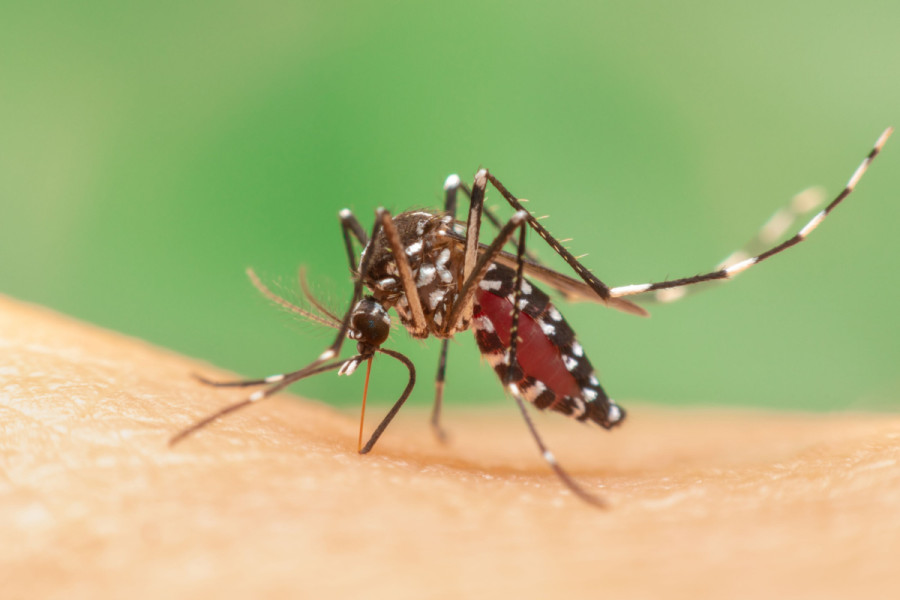Columns
The rise of post-acute dengue syndrome
The ability of the dengue virus to cause long-term post-acute infection sequelae is alarming.
Dr Sher Bahadur Pun
Following the massive 2022 dengue outbreak, post-acute dengue syndrome is becoming apparent and drawing more attention in Nepal. A few days ago, a staff member at the Sukraraj Tropical & Infectious Disease Hospital resumed work after recovering from dengue. But he was still complaining of severe fatigue, weakness, and muscle and joint pain. Very recently, a retired hospital staff, who was also infected with dengue with severe symptoms, was continuously experiencing severe fatigue, asthenia and significant hair loss. In another case, a young woman, who had recovered from dengue fever a month ago, again visited the hospital with complaints of severe fatigue, joint pain (especially in the lower limbs), feeling feverish but without fever, headache, and brain fog (trouble with memory, inability to concentrate etc.).
Other notable health problems reported after recovery from dengue infection include difficulty breathing while talking, dizziness, heavy head, sleep disturbances or sleepiness and heart palpitations. It is observed that people with post-acute dengue syndrome experienced/are experiencing at least two or more symptoms. Such complaints were not noticed or reported during the first massive dengue outbreak in 2019.
There is, so far, no consensus on the most appropriate name for the post-acute sequelae of dengue fever and its time frame among scientific experts, although several studies on the persistent symptoms after recovering from the acute phase of dengue infection have been published in the past. Initially, there was no clear consensus on defining the post-acute sequelae of Covid-19. It was popularly known as “long Covid”, “long-haul Covid”, “chronic Covid”, and “post-Covid”. It was later defined as “an individual with a history of probable or confirmed SARS-CoV-2 infection, usually three months from the onset of Covid-19, with symptoms that last for at least two months and cannot be explained by an alternative diagnosis”. During the current 2022 dengue outbreak, most of the cases recovered eight to 10 days after symptoms first appeared. Thus, if the patient experiences symptoms (physical and/or mental) at least 10 days after the onset of the illness, the author herein refers to it as post-acute dengue syndrome.
Several countries have previously reported post-acute dengue syndrome. In Sri Lanka, nearly one-third of dengue patients were found to have symptoms of post-dengue fatigue one to two months after infection. A six-month or longer follow-up study conducted in Brazil found that half of the dengue patients (54 percent) reported various symptoms that persisted for more than 14 days. In a study done in Cuba, over half (57 percent) of the individuals with a prior diagnosis of dengue fever found persistent clinical symptoms in the two years following infection/after their diagnosis. It shows that post-acute dengue syndrome is not rare and may go unnoticed due to lack of research, study or attention.
Nonetheless, heretofore, post-acute dengue syndrome has not yet been widely recognised in Nepal. In light of the current dengue outbreak in Nepal, the sudden rise in post-acute dengue syndrome can be considered as an unexpected but possibly a new emerging event.
Individuals living with post-acute dengue syndrome frequently asked questions about its duration (possible end time) and potential drugs for the treatment. There are, thus far, not enough published studies that mention or explain its management and lingering time. However, symptomatic treatment or supportive care from related field specialists could help improve the symptoms. Some studies found that the post-acute sequelae of dengue infection resolved over time without any specific treatment. As to its duration, it is not well known how long it lasts for. A Brazilian study found that symptoms persisted for up to one month in 44 percent of dengue patients, while symptoms remained for up to six months in the other 44 percent. Nevertheless, it can be as long as two years following the resolution of the acute phase infection, as shown by a Cuban study group. Nepal is witnessing a sudden surge of such syndrome for the first time in an increasing number of patients after recovery. Hence, its outcomes and time duration are yet to be known or studied.
The ability of the dengue virus to cause long-term post-acute infection sequelae is alarming. Despite this, there is still a lack of research studies or interest in understanding the reasons behind this sequelae. Several interesting findings about dengue infection and its post-acute sequelae are emerging. For example, why a significant number of patients are having post-acute dengue syndrome following the current 2022 dengue outbreak, although the virus has been circulating in the population for about 18 years (first reported in 20004) in Nepal?
Some studies found that symptomatic patients, especially those who experienced severe symptoms or went through warning signs of dengue fever, are at greater risk of having post-acute dengue syndrome. This means that hundreds of patients, who recently recovered from the disease, are expected to suffer from post-acute dengue syndrome in the coming days or months, as we observed most of the patients with severe symptoms of dengue virus, including bleeding complaints during the current 2022 dengue outbreak. Studies have found that females with dengue are at higher risk of having a post-acute dengue syndrome than their male counterparts. So far, the majority of the patients who complained of persistent symptoms after recovery from acute dengue infection were female. At present, the reasons behind these findings are not well explained and are yet to be explained.
For the first time, post-acute dengue syndrome is increasingly seen among dengue patients after recovery from the virus in Nepal. Previous studies have observed the overall prevalence rate of the syndrome was about 50-60 percent or nearly half of the dengue patients. It is, thus, reasonable to anticipate a similar prevalence rate of post-acute dengue syndrome in dengue patients in the months or even years to come in Nepal.




 6.12°C Kathmandu
6.12°C Kathmandu













%20(1).jpg&w=300&height=200)

